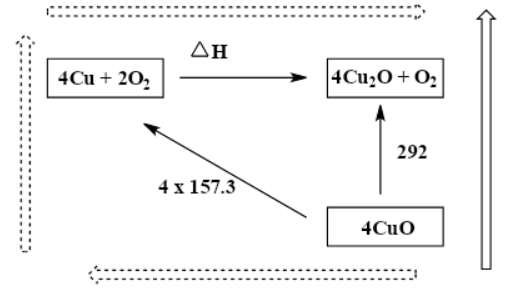
How do you draw a Hess’s law diagram?
Answer
435.3k+ views
Hint: The Hess’s law is major in physical chemistry which states that the total enthalpy change for a reaction is independent of the route by which the chemical change takes place. Formation of heat is defined as the enthalpy change which accompanies the formation of substance in a standard state from its elements also taken in standard state.
Complete step by step solution:
As we know that Hess law takes the independent route for the reaction. In thermodynamics, we need the initial and final states. So, we need to construct a Hess Cycle using the given information;

While we observe the diagram, in terms of energy, the dashed long route is equal to the black arrow route as the arrows start and finish in the same place. This diagram represents and follows the Hess law. So, we can write as; $(4\times 157.3)+\Delta H=292$
Therefore, $\Delta H=-337.2kJ$
We have found $\Delta H$ for below equation; \[4Cu+2{{O}_{2}}\to 2C{{u}_{2}}O+{{O}_{2}}\]
This means the same ; \[4Cu+{{O}^{2}}\to 2C{{u}_{2}}O\text{ }\]
This means the formation of two moles of copper(I) oxide. So, we need to find the change in enthalpy for the formation of copper(I) oxide. Therefore,
\[\Delta {{H}_{f}}\left[ C{{u}_{2}}O \right]\text{=}\dfrac{\Delta H}{2}=-\dfrac{337.2}{2}=-168.6\text{ }kJ/mol\text{ }\]
So, for the formation of one mole of copper(I) oxide we need \[-168.6\text{ }kJ/mol\text{ }\] enthalpy.
Note: We must know that Hess’s law is a version of the fine law of thermodynamics. So, it means the energy is always conserved. Often Hess’s law cycles are used to measure the change in enthalpy for a reaction that can’t be measured directly by experiments. Instead, the alternative method/ reactions are carried out that can be measured experimentally.
Complete step by step solution:
As we know that Hess law takes the independent route for the reaction. In thermodynamics, we need the initial and final states. So, we need to construct a Hess Cycle using the given information;

While we observe the diagram, in terms of energy, the dashed long route is equal to the black arrow route as the arrows start and finish in the same place. This diagram represents and follows the Hess law. So, we can write as; $(4\times 157.3)+\Delta H=292$
Therefore, $\Delta H=-337.2kJ$
We have found $\Delta H$ for below equation; \[4Cu+2{{O}_{2}}\to 2C{{u}_{2}}O+{{O}_{2}}\]
This means the same ; \[4Cu+{{O}^{2}}\to 2C{{u}_{2}}O\text{ }\]
This means the formation of two moles of copper(I) oxide. So, we need to find the change in enthalpy for the formation of copper(I) oxide. Therefore,
\[\Delta {{H}_{f}}\left[ C{{u}_{2}}O \right]\text{=}\dfrac{\Delta H}{2}=-\dfrac{337.2}{2}=-168.6\text{ }kJ/mol\text{ }\]
So, for the formation of one mole of copper(I) oxide we need \[-168.6\text{ }kJ/mol\text{ }\] enthalpy.
Note: We must know that Hess’s law is a version of the fine law of thermodynamics. So, it means the energy is always conserved. Often Hess’s law cycles are used to measure the change in enthalpy for a reaction that can’t be measured directly by experiments. Instead, the alternative method/ reactions are carried out that can be measured experimentally.
Recently Updated Pages
The correct geometry and hybridization for XeF4 are class 11 chemistry CBSE

Water softening by Clarks process uses ACalcium bicarbonate class 11 chemistry CBSE

With reference to graphite and diamond which of the class 11 chemistry CBSE

A certain household has consumed 250 units of energy class 11 physics CBSE

The lightest metal known is A beryllium B lithium C class 11 chemistry CBSE

What is the formula mass of the iodine molecule class 11 chemistry CBSE

Trending doubts
State the laws of reflection of light

One Metric ton is equal to kg A 10000 B 1000 C 100 class 11 physics CBSE

Difference Between Prokaryotic Cells and Eukaryotic Cells

How do I convert ms to kmh Give an example class 11 physics CBSE

Describe the effects of the Second World War class 11 social science CBSE

Which of the following methods is suitable for preventing class 11 chemistry CBSE




